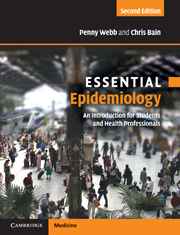Book contents
- Frontmatter
- Contents
- Foreword
- Preface
- 1 Epidemiology is…
- 2 How long is a piece of string? Measuring disease frequency
- 3 Who, what, where and when? Descriptive epidemiology
- 4 Healthy research: study designs for public health
- 5 Why? Linking exposure and disease
- 6 Heads or tails: the role of chance
- 7 All that glitters is not gold: the problem of error
- 8 Muddied waters: the challenge of confounding
- 9 Reading between the lines: reading and writing epidemiological papers
- 10 Who sank the boat? Association and causation
- 11 Assembling the building blocks: reviews and their uses
- 12 Outbreaks, epidemics and clusters
- 13 Watching not waiting: surveillance and epidemiological intelligence
- 14 Prevention: better than cure?
- 15 Early detection: what benefits at what cost?
- 16 A final word…
- Answers to questions
- Appendix 1 Direct standardisation
- Appendix 2 Standard populations
- Appendix 3 Calculating cumulative incidence and lifetime risk from routine data
- Appendix 4 Indirect standardisation
- Appendix 5 Calculating life expectancy from a life table
- Appendix 6 The Mantel-Haenszel method for calculating pooled odds ratios
- Appendix 7 Formulae for calculating confidence intervals for common epidemiological measures
- Glossary
- Index
- References
16 - A final word…
- Frontmatter
- Contents
- Foreword
- Preface
- 1 Epidemiology is…
- 2 How long is a piece of string? Measuring disease frequency
- 3 Who, what, where and when? Descriptive epidemiology
- 4 Healthy research: study designs for public health
- 5 Why? Linking exposure and disease
- 6 Heads or tails: the role of chance
- 7 All that glitters is not gold: the problem of error
- 8 Muddied waters: the challenge of confounding
- 9 Reading between the lines: reading and writing epidemiological papers
- 10 Who sank the boat? Association and causation
- 11 Assembling the building blocks: reviews and their uses
- 12 Outbreaks, epidemics and clusters
- 13 Watching not waiting: surveillance and epidemiological intelligence
- 14 Prevention: better than cure?
- 15 Early detection: what benefits at what cost?
- 16 A final word…
- Answers to questions
- Appendix 1 Direct standardisation
- Appendix 2 Standard populations
- Appendix 3 Calculating cumulative incidence and lifetime risk from routine data
- Appendix 4 Indirect standardisation
- Appendix 5 Calculating life expectancy from a life table
- Appendix 6 The Mantel-Haenszel method for calculating pooled odds ratios
- Appendix 7 Formulae for calculating confidence intervals for common epidemiological measures
- Glossary
- Index
- References
Summary
In the preceding chapters we have covered the core principles and methods of epidemiology and have shown you some of the main areas where epidemiological evidence is crucial for policy and planning. You will also have gained a sense of the breadth and depth of the subject from the examples throughout the book. To finish off we will take a step back and take a broader look at the roles epidemiological practice and logic play in improving health.
We might start by exploring the boundaries of epidemiology. The definitions given in Chapter 1 are not limiting and imply wide engagement with all influences on health – epidemiology is a ‘big-picture’ discipline. The proximal causes of disease (e.g. infectious agents, industrial toxins, smoking, diet) are inextricably intertwined with the social, economic and physical environments, so epidemiology must give due attention to these upstream (distal) drivers of a population's health; you have already seen examples of this in Chapter 1 and in the discussion of infectious diseases in Chapter 12 and prevention in Chapter 14.
In 1848, a year of political revolution in Germany and elsewhere in Europe, the great German medical scientist Rudolph Virchow was sent by the Prussian government to investigate an epidemic fever raging among the destitute Polish weavers of Silesia. He diagnosed it as typhus or relapsing fever, noting that such mass phenomena have mass causes (Virchow, 1985, cited by Drotman, 1998; Azar, 1997).
- Type
- Chapter
- Information
- Essential EpidemiologyAn Introduction for Students and Health Professionals, pp. 375 - 387Publisher: Cambridge University PressPrint publication year: 2010

